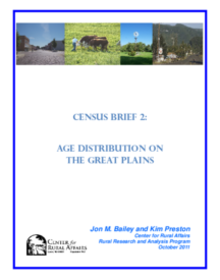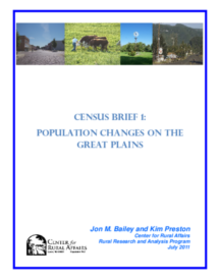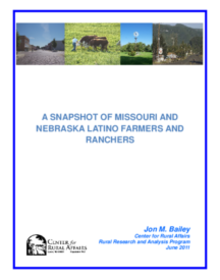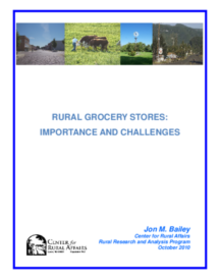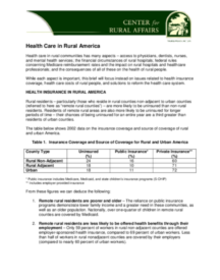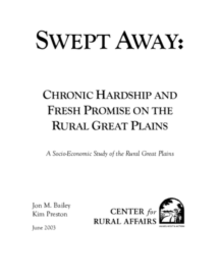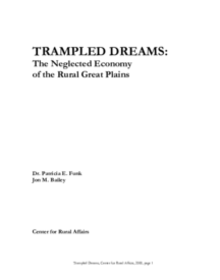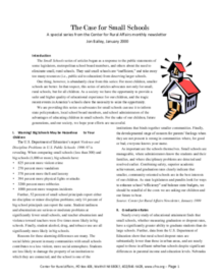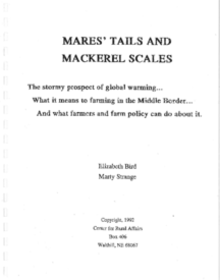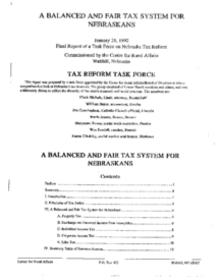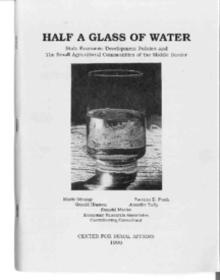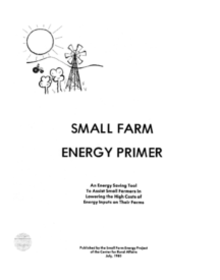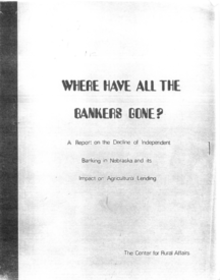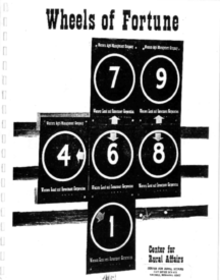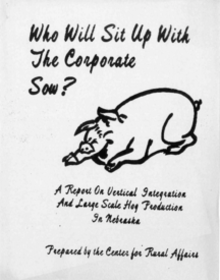We aren't afraid of the weeds. The people living in rural America deserve a serious and in-depth look at the issues and forces impacting their communities.
This brief will examine the age distribution of the region, an important short and long-term demographic and social and economic issue. This is the second in a series of briefs examining data from the 2010 Census.
- Small Towns
A robust electric grid is vital to the health of any economy. Successful improvement of the decades-old infrastructure already in place will enhance reliability, allow for the seamless integration of renewable resources and account for heightened electricity demand. This effort will open the door to...
- Policy
Data from the 2010 Census show that rural areas in the Great Plains and Midwest continue to lose population, while smaller cities and metropolitan areas continue to expand.
- Small Towns
This report highlights selected data from the 2007 U.S. Department of Agriculture Census of Agriculture on several aspects of Latino farmers and ranchers in Missouri and Nebraska. These data provides a broader view of the current status of Latino farmers and ranchers in both states. Summary of data...
- Farm and Food
The local grocery store is an integral institution of rural communities and in rural life. Not only does the local grocery store provide the sustenance of life, it fills the roles of economic driver, community builder, employer and meeting place. Unfortunately, many rural communities across the...
- Small Towns
Health care in rural communities has many aspects – access to physicians, dentists, nurses, and mental health services; the financial circumstances of rural hospitals; federal rules concerning Medicare reimbursement rates and the impact on rural hospitals and healthcare professionals; and the...
- Small Towns
"Swept Away: Chronic Hardship and Fresh Promise on the Rural Great Plains" describes the economic conditions of agriculturally-based communities in the six-state region of Iowa, Kansas, Minnesota, Nebraska, North Dakota, and South Dakota. We identified 182 counties (of 503) throughout this region as...
- Farm and Food
- Small Towns
"Trampled Dreams: The Neglected Economy of the Rural Great Plains" describes the economic conditions of small agricultural communities as compared to other urban and metropolitan areas in a six-state region comprised of Iowa, Kansas, Minnesota, Nebraska, North Dakota and South Dakota. Based on the...
- Small Towns
The "Small Schools" series of articles began as a response to the public statements of some legislators, metropolitan school board members, and others about the need to eliminate small, rural schools. They said small schools are “inefficient,” and take away too many resources (i.e., public aid to...
- Small Towns
The old timers used to say that when clouds took the shape of mares' tails or mackerel scales, a storm would soon strike. Although weather forecasting is more technical today, it might not be much more accurate, especially if so-called ''greenhouse gas'' emissions destabilize the climate and increase the uncertainty of weather events. The prospect of more erratic and perhaps more violent weather patterns is especially troublesome to farmers, whose livelihoods are traumatized by unstable agronomic conditions. Mares tails and mackerel scales spell trouble on the farm.
- Farm and Food
- Policy
This is the final report of a task force on Nebraska tax reform. It was commissioned by the Center for Rural Affairs and published in January 1992. The task force found that Nebraska's tax system suffered from three major faults: Nebraska depends too heavily on property tax. It provided 46 percent...
- Lending
Two Rutgers University geographers caused quite a stir when they suggested that the Great Plains will inevitably become largely depopulated and that "the wisest thing the federal government can do is start buying back great chunks of the Plains, replant the grass, reintroduce the bison—and turn out the lights.”
- Policy
The "Small Farm Energy Primer" is a collection of reports on energy alternatives and conservative techniques to help lower the high costs of energy inputs on small farms. The reports, entitled, "Project Focus," include innovations built by northeast Nebraska farmers who participated in the Small...
- Policy
As an independent banker who has been outspoken on banking matters for many years, I am pleased to present for the consideration of the public as well as the banking industry, this report on the impact of bank ownership on farm credit in Nebraska. Although the report represents the first stage of a...
- Small Towns
As an irrigator who lives in one of the fastest developing irrigation areas of the state, I was pleased to serve on the study committee which oversaw the preparation of this report. The committee, consisting of two other irrigators and a University of Nebraska economist, was established by the Board...
- Farm and Food
- Policy
The 1974 Center for Rural Affairs report on vertical integration and large-scale hog production – "Who Will Sit Up With The Corporate Sow?" – accurately predicted the most onerous impacts that consolidation and vertical integration would have on family farm hog producers over the last 30 years. The...
- Farm and Food


